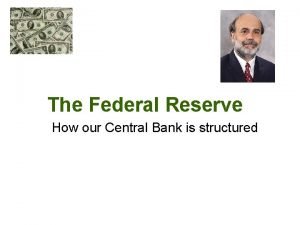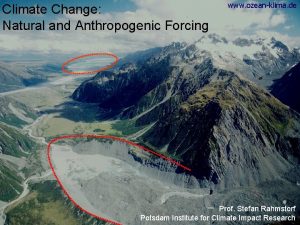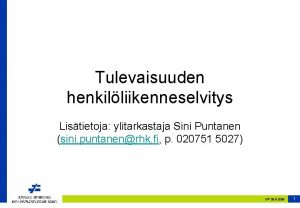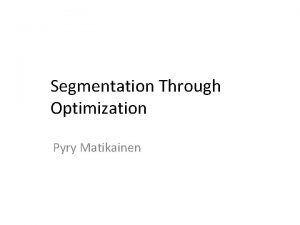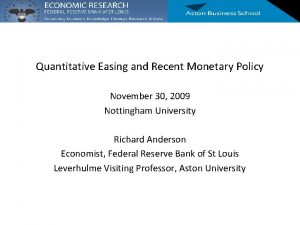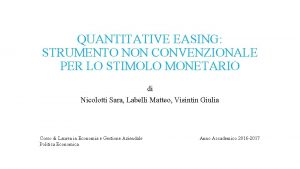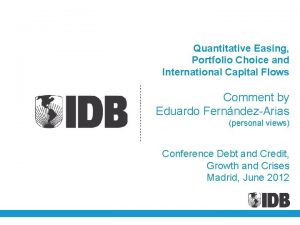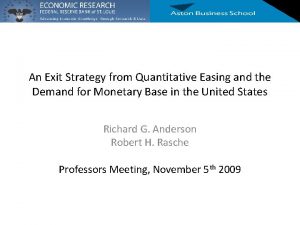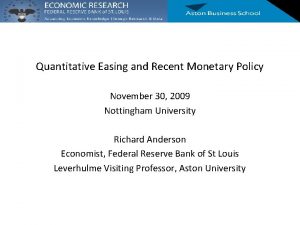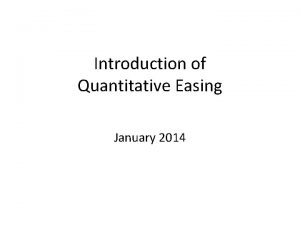The climate impact of quantitative easing Sini Matikainen



























- Slides: 27

The climate impact of quantitative easing Sini Matikainen - Grantham Research Institute on Climate Change and the Environment, LSE Presentation based on policy brief ‘The Climate Impact of Quantitative Easing’ 20 November, 2017 University of Helsinki

Outline 1. Background: climate change risk 2. Reaction of supervisory authorities and central banks 3. Sectoral impacts of QE 4. Analysis: ECB and Bank of England corporate bond purchases 5. Conclusions and next steps 2

Background: climate change risk • Physical damages • Liability • Transitional • • Policy changes • Technological change • Consumer demand Potentially affecting the value of: • Commodities (oil, gas, coal) • Long term infrastructure • Firms (extraction, refining, distribution) • Sovereigns • Investors and wider financial system Source: BNEF (2016) 3

Response from central banks and supervisory authorities • Increasing amount of attention • Largely focusing on: • disclosure requirements • stress testing Institutions (partial list) G 20 (Green Finance Study Group) Bank of England Banque de France Dutch National Bank European Systemic Risk Board Financial Stability Board Banca d’Italia Finansinspektionen (Sweden) Lebanese Central Bank People’s Bank of China European Commission (High Level Expert Group on Sustainable Finance) 4

Why should the ECB consider climate change? • Mandate: • According to Article 127 of the Treaty of the Functioning of the European Union (2012): ‘…without prejudice to the objective of price stability, the ESCB shall support the general economic policies in the Union with a view to contributing to the achievement of the objectives of the Union’ • which are defined in Article 3 as including: ‘social progress, and a high level of protection and improvement of the quality of the environment’. • Financial stability • Academic and practical interest: what are the effects of monetary policy instruments and implications for macroprudential policy? 5

What is the ECB purchasing? Changes of holdings Asset Backed Securities Purchase Programme (ABSPP) Covered Bond Purchase Programme 3 (CBPP 3) Corporate Sector Purchase Programme (CSPP) Public Sector Purchase Programme (PSPP) Asset Purchase Programme (APP) 24, 076 231, 314 114, 658 1, 748, 063 2, 118, 111 Monthly net purchases 605 4, 686 6, 949 50, 174 62, 414 Holdings Oct 2017* 236, 000 121, 607 1, 798, 237 2, 180, 526 Holdings Sept 2017* 24, 682 Total *Note: At amortised cost, in million euros, at month end. Figures may not add up due to rounding. Figures are preliminary and subject to change. Source: ECB (2017) 6

How green are these asset purchases? • Public sector purchases • • Equities • • • Depends on government support for low-carbon activities Nikkei 225 sector weight Different sectoral distribution from bond market (debt vs. equity financing) Technology Financials Consumer goods Asset-backed securities • Lack of transparency Materials • Depends on underlying (E. g. , Volkswagen) Capital Goods/others Covered bonds • Constrained in issuance • Excludes renewable energy loans (Damerow, 2014) Source: Nikkei, Dec. 2016 Transportation and utilities 7

Carbon intensity of (estimated) purchases (ECB) 18% Manufacturing* 16% Percentage of GVA 14% 12% Real estate activities Wholesale and retail trade 10% 8% Transportation and storage 6% Financial and insurance activities 4% Administrative Electricity, gas, steam and air conditioning supply Information and communication Chemicals and chemical products Refined petroleum and coke production 2% 0% 0% 5% 10% 15% 20% Estimated percentage of purchases 25% 30% 35% Notes: Size of the bubble indicates relative contribution to emissions in euro-area countries. 8 Sources: ECB (ISINs, as of February 2017), Bloomberg (NACE categories, 2017), Eurostat (emissions and GVA data, as of 2013), and authors’ calculations.

Carbon intensity of Euro corporate bond markets 1: BICS* sector classification name 2: All Euro corporate bonds (%) 3: All corporate 4: Corporate 5: Investment grade bonds except bonds of eligible corporate bonds of finance (%) maturity (%) eligible maturity (%) 6: CSPP eligible (%) 7: Estimated purchases (%) Communications 4. 38 13. 10 12. 81 10. 78 11. 54 11. 11 Consumer discretionary 5. 08 15. 20 15. 34 12. 52 14. 37 11. 07 2. 16 6. 47 6. 19 7. 98 9. 85 6. 84 2. 35 7. 02 7. 43 8. 43 7. 71 8. 57 Food & beverage 1. 52 4. 55 4. 94 5. 97 7. 00 6. 97 Energy Integrated oils 2. 55 1. 71 7. 64 5. 11 7. 29 4. 68 8. 25 6. 03 8. 63 7. 58 9. 54 8. 40 Renewable energy 0. 18 0. 55 0. 54 0. 26 0. 02 0. 00 70. 72 0. 00 1. 76 3. 99 3. 57 0. 64 4. 97 12. 35 0. 00 5. 26 11. 93 10. 69 1. 92 14. 89 11. 13 0. 00 5. 29 12. 72 11. 16 1. 96 14. 87 12. 30 0. 00 5. 98 11. 10 8. 55 1. 64 20. 45 8. 64 0. 00 4. 31 11. 16 7. 62 1. 58 24. 45 8. 36 2. 62 4. 26 10. 63 7. 39 1. 78 24. 67 Automobiles manufacturing Consumer staples Financials** Government*** Health care Industrials Materials Technology Utilities Notes: *BICS = Bloomberg Industrial Classification System. **Financial institutions under supervision are excluded from purchase; however, other financial actors such as real estate and financial services are eligible. *** As detailed in Appendix 1, Columns 1– 6 are based on a search of ECB-eligible bonds from Bloomberg Terminal, which excludes ‘government’ bonds as ineligible (using BICS sector classification). Column 7 is based on the list of international securities identification numbers (ISINs) provided by the ECB, in which four government-backed entities 9 appear: Deutsche Bahn, SNCF, Sagess and RATP group. Sources: Bloomberg (2017); ECB (2017), authors’ own calculations.

Carbon intensity of eligible assets (Bo. E) 16% 14% Real estate activities Percentage of GVA 12% Wholesale and retail trade 10% 8% Health and social work Electricity, gas, steam and air conditioning supply Transportation and storage 4% 2% Information and communication Education 6% Manufacturing* Mining and quarrying Manufacture of petroleum 0% 0% 5% Water supply 10% 15% 20% Percentage of benchmark for purchases 25% 30% 35% Notes: Size of the bubble indicates relative contribution to emissions in euro-area countries. Sources: Bo. E (ISINs, as of February 2017), Bloomberg (NACE categories, 2017), Eurostat (emissions and GVA data, as of 2013), and authors’ calculations. *Manufacturing excludes 10 manufacture of petroleum.

Carbon intensity of UK corporate bond markets 5: CBPP eligible (%) 7: Bank of England benchmark list of eligible bonds (%) 12. 48 12. 89 12. 23 18. 49 13. 10 13. 32 10. 83 4. 22 3. 44 3. 37 3. 46 3. 42 5. 42 8. 96 8. 88 7. 98 8. 09 10. 50 Food & beverage 1. 67 2. 76 2. 62 2. 38 2. 30 1. 72 Energy Integrated oils 2. 23 1. 35 3. 70 2. 24 3. 59 2. 28 3. 68 2. 33 3. 81 2. 42 2. 95 1. 83 Renewable energy 0. 02 0. 03 0. 00 46. 89 0. 00 2. 48 5. 02 1. 26 0. 51 16. 25 12. 11 0. 00 4. 10 8. 31 2. 08 0. 85 26. 89 12. 55 0. 00 4. 30 8. 58 1. 86 0. 87 27. 73 11. 13 0. 00 4. 48 9. 71 2. 31 1. 14 33. 99 11. 06 0. 00 4. 54 9. 71 2. 40 1. 18 33. 00 6. 60 2. 80 5. 85 6. 15 1. 20 1. 46 39. 44 2: All sterling corporate bonds (%) 3: All corporate bonds except finance (%) Communications 8. 64 14. 29 13. 15 Consumer discretionary 11. 31 18. 71 2. 55 1: BICS* sector classification name Automobiles manufacturing Consumer staples Financials** Government*** Health care Industrials Materials Technology Utilities 4: All corporate 5: Investment grade bonds of eligible corporate bonds of maturity (%) eligible maturity (%) Notes: *BICS = Bloomberg Industrial Classification System. **Financial institutions under supervision are excluded from purchase; however, other financial actors such as real estate and financial services are eligible. *** As detailed in Appendix 1, Columns 1– 6 are based on a search of Bo. E-eligible bonds from Bloomberg Terminal, which excludes ‘government’ bonds as ineligible (using BICS sector classification). Column 7 is based on the list of international securities identification numbers (ISINs) provided by the Bo. E, in which four government-backed entities 11 appear: Deutsche Bahn, SNCF, Sagess and RATP group. Sources: Bloomberg (2017); Bank of England (2017), authors’ own calculations.

Carbon intensity of purchases: main points • Manufacturing and electricity production: • • • Chemical and petroleum products: • also emissions-intensive (especially when considering emission accounting) • contribute less than 1% of Eurozone GVA Wholesale and retail trade, real estate: • • 62. 1% of purchases, 58. 5% of Eurozone area emissions, but only 18% of GVA. Relatively small percentage of purchases, though they contribute a relatively large amount to GVA and relatively little to emissions. Reflects the bond market (high capital intensity of manufacturing and utilities, use of debt financing) and eligibility criteria 12

Effects of corporate bond purchases • Additional debt issuance and lower borrowing costs (Buell, 2016; Yap, 2016). • Widening yield spreads between: • purchased and unpurchased assets • eligible and ineligible bonds (Keohane, 2016) Source: Keohane (2016) 13

Energy sector: oil and gas • ECB: Apetra, ENI, OMV, Petrol, Shell, Repsol, Sagess, Schlumberger, Total, Transport ET and Vier Gas • Debt financing used for investment in longterm infrastructure, potentially contributing to carbon lock-in(Unruh, 2000). • Oil and gas sector is already heavily indebted, with concerns about credit default (particularly for emerging markets and smaller American producers) (Blas, 2016; Crooks, 2016; Loder et al. , 2016; Domanski et al. 2015) Source: Bakewell, 2016 14

Energy sector: renewables • No renewable energy bonds purchased (according to Bloomberg classification) • Why? • • Different financing structure (equity and loans) • Investment grade status • Other barriers to eligibility, e. g. as ABS? Importance of understanding funding channels: corporates, investment funds, development banks, project bonds, etc. Source: OECD, 2016 15

Next steps: research, disclosure, collaboration • • • Research • How central bank operations are affected by, but also could affect, transition risk • Working with relevant supervisory authorities on scenario analysis and stress testing Disclosure • Selection process, amounts purchased, and underlying assets (covered bonds and ABS) • Supporting the work of the FSB’s Task Force on Climate-Related Financial Disclosure Collaboration • Working with other relevant authorities such as EIB to address e. g. barriers to eligibility • Supporting the European Commission’s High Level Expert Group in Sustainable Finance 16

Possible future policy options • Though QE will begin tapering in 2018, ECB will keep reinvesting proceeds of maturing bonds • Revise risk criteria in purchasing decisions • • • Possible discrepancies in how credit ratings agencies assess climate risk Revise purchasing strategy • ‘Green’ bond market is small but expected to increase • Constraints in purchasing bonds from development banks Adjusting macro-prudential policy 17

Thank you! Full paper available from: http: //www. lse. ac. uk/Grantham. Institute/publication/the-climateimpact-of-quantitative-easing/ 18

References (full list in paper) Bakewell, S. , 2016. Negative Yields Seep Into Shell, Siemens Debt on ECB Distortions. Bloomberg. com. Battiston, S. , Mandel, A. , Monasterolo, I. , Schuetze, F. and Visentin, G. , 2016. A climate stresstest of the financial system. Blas, J. , 2016. Crude Slump Sees Oil Majors’ Debt Burden Double to $138 Billion [Online]. Bloomberg. com. Crooks, E. , 2016. Standard & Poor’s cuts ratings of US oil and gas groups. Financial Times. Carney, M. , 2016. Resolving the climate paradox. [Speech] Carney, M. , 2015. Breaking the Tragedy of the Horizon–climate change and financial stability. Speech Lloyd’s of London. Damerow, F. , Kidney, S. , Clenaghan, S. , 2012. How Covered Bond markets can be adapted for Renewable Energy Finance and how this could Catalyse Innovation in Low-Carbon Capital Markets. Climate Bond Initiative. Domanski, D. , Kearns, J. , Lomabrdi, M. , Song Shin, H. , 2015. Oil and debt [WWW Document]. Bank for International Settlements. ESRB, 2016. Too late, too sudden - Transition to a low-carbon economy and systemic risk. European Systemic Risk Board. GFSG, 2016. G 20 Green Finance Synthesis Report. Green Finance Study Group. Haldane, A. , Roberts-Sklar, M. , Wieladek, T. , Young, C. , 2016. QE: the story so far (Staff working paper No. 624). Bank of England. Joyce, M. , Lasaosa, A. , Stevens, I. , Tong, M. , 2010. The financial market impact of quantitative easing (Working Paper No. 393). Bank of England. Joyce, M. , Liu, Z. , Tonks, I. , 2015. Institutional investor investment behaviour during the Crisis and the portfolio balance effect of QE. Vox. EU. org. Keohane, D. , 2016. It feels good to be CSPP’d. Financial Times. Khemraj, T. , Yu, S. , 2016. The effectiveness of quantitative easing: new evidence on private investment. Applied Economics 48, 2625– 2635. doi: 10. 1080/00036846. 2015. 1125439 Krishnamurthy, A. , Vissing-Jorgensen, A. , 2012. The Aggregate Demand for Treasury Debt. Journal of Political Economy. 120, 233– 267. doi: 10. 1086/666526 Krishnamurthy, A. , Vissing-Jorgensen, A. , 2011. The Effects of Quantitative Easing on Interest Rates: Channels and Implications for Policy (Working Paper No. 17555). National Bureau of Economic Research. Lewin, J. , 2016. Bo. E corporate bond buying in five charts [Online]. Financial Times. Available from: http: //www. ft. com/fastft/2016/08/04/boe-corporate-bond-buying-in-five-charts/ (accessed 1. 25. 17). Liebreich, M. , 2016. State of the Industry Keynote BNEF Summit 2016. Available from: https: //about. bnef. com/blog/liebreich-state-of-the-industry-keynote-bnef-summit-2016/ Mc. Glade, C. , Ekins, P. , 2015. The geographical distribution of fossil fuels unused when limiting global warming to 2 °C. Nature 517, 187– 190. doi: 10. 1038/nature 14016 OECD, 2016 a. Analysing potential bond contributions in a low-carbon transition [Online]. Available from: http: //www. oecd. org/cgfi/quantitative-framework-bond-contributions-in-a-lowcarbon-transition. pdf (accessed 1. 10. 17). Prudential Regulation Authority, 2015. The impact of climate change on the UK insurance sector. Rogers, J. , 2014. FRB: Evaluating Asset-Market Effects of Unconventional Monetary Policy: A Cross-Country Comparison. Federal Reserve Board. Available from: http: //www. federalreserve. gov/pubs/ifdp/2014/1101/default. htm Ryan-Collins, J. , 2013. Strategic quantitative easing. New Economics Foundation. Available from: http: //www. neweconomics. org/publications/entry/strategic-quantitative-easing TCFD, 2016. Recommendations of the Task Force on Climate-related Financial Disclosures. Available from: https: //www. fsb-tcfd. org/publications/recommendations-report/ Unruh, G. C. , 2000. Understanding carbon lock-in. Energy Policy 28, 817– 830. doi: 10. 1016/S 0301 -4215(00)00070 -7 Yap, K. L. M. Y. , 2016. Corporate Europe Embraces Bonds as Yields Plunge to Record Low. Bloomberg. Available from: https: //www. bloomberg. com/news/articles/2016 -09 -07/corporatebond-sales-swell-in-europe-as-yields-slump-to-record 19

Background slides 20

Targeted use of monetary policy instruments • Federal Reserve: purchases of mortgage-backed securities in its first round of QE from 2008 to 2010 • Cleaned up banks’ balance sheets from underperforming and illiquid assets • Freed them to extend more credit to the larger economy and helped to lower mortgage rates (Khemraj and Yu, 2016; Krishnamurthy and Vissing-Jorgensen, 2011; Ryan-Collins, 2013). • Analysis suggests a wider macroeconomic impact than the second round of QE in 2011, which focused on Treasury bonds only (Krishnamurthy and Vissing-Jorgensen, 2011). • ECB: Long-term refinancing operations to encourage lending to real economy • Bank of England’s Funding for Lending Scheme has targeted household lending (until November 2013) and lending to SMEs • Bank of Canada: Purchased bonds issued by the Canadian Industrial Development Bank to support loans to SMEs (Ryan-Collins (2013). 21

Installed capacity (GW): IEA forecast and actual Source: BNEF (2016) 22

Equity holdings in EU and US listed companies in 2015 Source: Battiston et al. (2017) 23

Potential losses to European banks Source: Battiston et al. (2017) 24

Are these risks priced in? • Ongoing topic of research • Efficient market hypothesis (Fama, 1970) suggests risks should be priced in, but: • investors may not find future climate policy credible, or underestimate the speed of technological change • may lack sufficient information to make the assessment (TCFD, 2016) • cognitive biases (Schiller, 2000; Kahnemann, 1975) • or face other institutional and normative barriers related to time horizons (Carney, 2015) • Also depends on future of technological development (e. g. CCS) and renewable deployment • Extent of mispricing is unknown, but could be significant 25

QE: stylized transmission mechanism • Asset purchases used as unconventional monetary policy instrument • Targeting broad-based growth • Aiming for neutrality in the sense of avoiding market distortions Source: Authors, based on Benford (2009) 26

Theoretical implications of choice of purchased asset • • Academic literature suggests frictions in transmission mechanism: • Impact of QE is easiest to demonstrate on asset being purchased, with impact on other assets is more difficult to separate from other influences (Joyce et al. , 2010). • Assets with a similar risk profile benefit relatively more than higher-risk bonds (Krishnamurthy and Vissing-Jorgensen, 2011, 2012; Rogers, 2014). • In the UK, micro-analysis of institutional investors shows that the purchase of Gilts resulted in some portfolio rebalancing effects towards corporate bonds, but not equities (Joyce et al. , 2015). Which suggests differential effects between purchased and unpurchased assets (Rogers 2014) 27
 Sini matikainen
Sini matikainen Quantitative easing for dummies
Quantitative easing for dummies Quantitative easing wiki
Quantitative easing wiki Easing in fullness sewing
Easing in fullness sewing Sanna matikainen
Sanna matikainen Juha matikainen
Juha matikainen Sini ignatius
Sini ignatius Critical angle formula
Critical angle formula Scratchilla
Scratchilla N=sini/sinr
N=sini/sinr Climate change 2014 mitigation of climate change
Climate change 2014 mitigation of climate change Climate types brainpop
Climate types brainpop The potsdam institute for climate impact research
The potsdam institute for climate impact research Impact of climate change on forest ppt
Impact of climate change on forest ppt Tư thế ngồi viết
Tư thế ngồi viết Diễn thế sinh thái là
Diễn thế sinh thái là V cc
V cc Thể thơ truyền thống
Thể thơ truyền thống Làm thế nào để 102-1=99
Làm thế nào để 102-1=99 Chúa sống lại
Chúa sống lại Khi nào hổ con có thể sống độc lập
Khi nào hổ con có thể sống độc lập đại từ thay thế
đại từ thay thế Vẽ hình chiếu vuông góc của vật thể sau
Vẽ hình chiếu vuông góc của vật thể sau Công thức tính thế năng
Công thức tính thế năng Tỉ lệ cơ thể trẻ em
Tỉ lệ cơ thể trẻ em Thế nào là mạng điện lắp đặt kiểu nổi
Thế nào là mạng điện lắp đặt kiểu nổi Hình ảnh bộ gõ cơ thể búng tay
Hình ảnh bộ gõ cơ thể búng tay Lời thề hippocrates
Lời thề hippocrates

